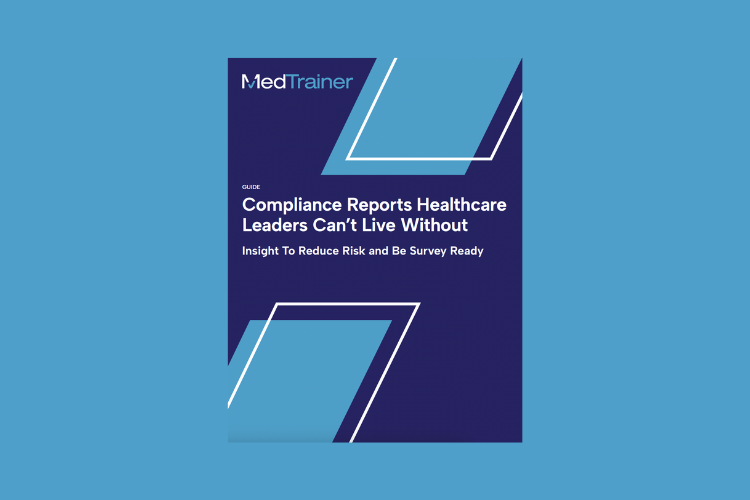Healthcare compliance. Many people may believe it encompasses only federal and industry regulations designed to keep patients safe. And they’d be partly right. But that’s only one aspect of this complex – and sometimes confusing – process. Just as perplexing is who is responsible for compliance in healthcare organizations. The answer has as many layers as the definition of compliance itself.
In this blog, we’ll outline the many roles that impact healthcare compliance, the pros and cons of each role’s management responsibilities, and what each is accountable for in concert with the others.
Healthcare Compliance Complexities
The first healthcare compliance programs began in the early 20th century as a response to concerns about the quality of care provided by medical practitioners. Licensing and credentialing were introduced to regulate healthcare professionals and ensure minimum standards of care. Law by law, regulations were added, increasing the complexity of maintaining compliance for healthcare organizations. Here are key dates in compliance history:
- 1965 – Medicare and Medicaid
- 1996 – Health Insurance Portability and Accountability Act (HIPAA)
- 2009 – Health Information Technology for Economic and Clinical Health (HITECH) Act
- 2010 – Affordable Care Act (ACA)
- 2015 – Medicare Access and CHIP Reauthorization Act (MACRA)
- 2023 – OIG Issues update – General Compliance Program Guidance
Today, healthcare compliance is dealing with the proliferation of telemedicine, wearable devices, and health apps that have raised new compliance challenges related to data security, patient consent, and remote care delivery.
Who in the Organization Is Responsible for Healthcare Compliance?
Regardless of the size of a healthcare organization, the Office of the Inspector General (OIG) recommends identifying a compliance contact who is responsible for ensuring that compliance activities are completed. This is one of seven components recommended in the OIG’s compliance guidelines.
The specific structure may vary depending on the organization’s size, structure, and regulatory environment. In large healthcare organizations, a compliance officer is typically responsible, however, in smaller organizations, such as physician practices, a case could be made for the entity’s compliance contact to be in one of several different roles. For all-size organizations, the owner(s)/executive team has a legal and ethical responsibility to maintain compliance.
Key Players Involved in Healthcare Compliance
| Role | Compliance Responsibilities | Pros and Cons |
| Chief Compliance Officer (CCO) | Develops, implements, and monitors the organization’s compliance program. | Pros: Executive-level leadership focused on compliance accountability, risk analysis, policy creation, and code of conduct enforcement.
Cons: High salary, potential conflicts of interest with other organizational responsibilities. |
| Compliance Department/Team | Dedicated group under the CCO. Responsible for day-to-day compliance activities, audits, adherence to policies and regulations, staff education, and training. Typically falls to one person on the team. | Pros: Diverse individuals with different perspectives and knowledge, collaborative problem-solvers, and accessibility to a team of experts.
Cons: Potential conflicts of interest with other organizational responsibilities. Can become bureaucratic and slow-moving. May not be aware of potential risks or incidents that are unreported. |
| Health Information Management (HIM) Department | Ensures the integrity and security of patient health information (PHI). Acts as a gatekeeper for system access and design. Assesses risk of data breaches and applies system and policy/procedure updates. | Pros: Familiar with privacy and security requirements and able to quickly respond to significant threats and incidents.
Cons: Limited focus on other aspects of compliance beyond HIM. |
| Legal Department | Works closely with the CCO and executive team to interpret and navigate healthcare laws and regulations. Advises on compliance matters, reviews contracts, and handles regulatory and legal issues. | Pros: Legal and regulatory compliance expertise, familiarity with laws and regulations, and trusted legal adviser.
Cons: Legal details may not be easily understood by all levels of the organization. Often has to be reactive to events and incidents rather than proactive collaboration. |
| Quality Improvement Department | Maintains and improves the quality of care the organization provides. Helps ensure compliance with clinical standards and guidelines. | Pros: Focus on continuous quality improvement, familiarity with regulations related to quality of care, and ability to develop policies and procedures.
Cons: Limited focus on other aspects of compliance beyond quality of care. May not have sufficient data to recognize competing priorities among staff. |
| Risk Management Department | Assesses potential risks and implements strategies to mitigate them. Includes compliance risks associated with regulatory violations. | Pros: Focus on identifying and mitigating risks, experience in developing policies and procedures related to risk management, and ability to resolve compliance issues.
Cons: Limited focus on other aspects of compliance beyond risk management. |
| Clinical & Administrative Departments | Adheres to regulations and guidelines within their specific licensing boards and department policies and procedures. | Pros: Familiarity with policies and procedures related to their specific areas, ability to identify non-compliance, and training staff.
Cons: Limited focus on other aspects of compliance beyond their specific areas. |
| Board of Directors | Ultimately responsible for the organization’s compliance efforts. Establishes a governance structure, reviews compliance reports, and ensures the organization operates ethically and within legal boundaries. | Pros: Penultimate compliance responsibility by providing oversight and feedback on the effectiveness of the policies & procedures.
Cons: Limited knowledge of day-to-day compliance issues, potential for conflicts of interest, and limited time and resources to devote to compliance. |
| Providers, Clinicians, and Staff Members | Comply with SOPs, report errors & non-compliance, and maintain personal responsibility for understanding and applying rules according to their role. | Pros: First-hand observation(s) of risky and non-compliant actions of themselves or others. Can be encouraged or incentivized to report.
Cons: May not be familiar with mandated reporting or may be apprehensive about reporting due to fear of retaliation. |
It’s important to note that collaboration among these various stakeholders is crucial to creating a robust and effective healthcare compliance program. Additionally, healthcare organizations must stay informed about regulation changes and adapt their compliance efforts accordingly.
Managing Healthcare Compliance Is A Team Sport
Though one person is an entity’s designated compliance contact, as you can see, every team member has a role in upholding the organization’s compliance. The entire staff maintains healthcare organizations’ integrity and legal adherence, helping protect patients, ensuring ethical practices, and avoiding legal repercussions. That’s why everyone must complete training, acknowledge policies, and actively report incidents.
Compliance software and comprehensive reporting can simplify these processes for everyone.
Compliance Training
- Employees: Online training in a learning management system can be completed on the go, making it easier for busy employees.
- Admins: Automated course reminders and completion tracking make it easy for admins to ensure adherence to regulations, and customizable reports keep you survey-ready.
Policy Management
- Employees: Having documents and policies accessible in a cloud-based system makes them easier for employees to follow, and electronic signing simplifies the acknowledgment process.
- Admins: One-click new hire onboarding makes it possible to assign policies by role, department, or location without the hassle.
Incident Reporting
- Employees: Submit incident reports quickly with online forms accessible anywhere. Plus, the option to report anonymously increases employees’ likelihood of reporting.
- Admins: Create multiple report templates to collect the information you need to handle incidents and gather data to identify trends quickly. Automated escalation speeds up resolution.

The best compliance and credentialing reports to surface critical insights and keep you survey ready.
Ready to learn more about all-in-one compliance software? See MedTrainer in action.
